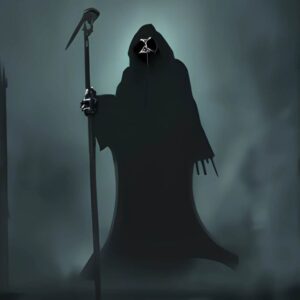The Role Of The Grim Reaper In Shaping Our Perception Of Death
6th April 2023
Categorized Under: Playscripts
Comments (0)
THE ROLE OF THE GRIM REAPER IN SHAPING OUR PERCEPTION OF DEATH
For centuries, people have been fascinated by the concept of death and the figure who presides over it – the Grim Reaper. This spectral figure, often depicted as a skeletal figure wielding a scythe, has come to symbolize the end of life and the transition from the physical realm to the afterlife. But where did this legend come from, and what stories surround it? Join us on a journey through time and explore the origins and tales of the Grim Reaper.
The Grim Reaper, also known as Death, is a figure in folklore and mythology, particularly in Western culture. The origin of the Grim Reaper myth can be traced back to ancient times when death was a natural part of life and often personified as a being who comes to take the soul of the dying.
One of the earliest recorded depictions of the Grim Reaper is found in medieval European art and literature. In these depictions, Death is often portrayed as a skeletal figure carrying a scythe, dressed in a long black cloak. In some cases, it is riding a horse or leading a procession of souls to the afterlife. Furthermore, one of the most famous depictions of the Grim Reaper from this time is the painting “The Triumph of Death” by Pieter Bruegel the Elder, created in 1562. The painting shows a landscape of death and destruction, with the Grim Reaper and his army of skeletons wielding scythes and wreaking havoc on the living. The painting is a powerful reminder of the fragility of life and the inevitability of death.
The Grim Reaper myth became particularly popular during the Black Death, a pandemic that swept Europe in the 14th century and killed millions of people. During this time, people began to associate the sudden and indiscriminate nature of the plague with the idea of Death as a figure who could strike at any time and take anyone’s life.
Additionally, The Grim Reaper appears in various religious and cultural traditions. In Greek mythology, the god Hades guides souls to the afterlife. In Hinduism, Yama is the god of death and judgment. In Christianity, Death is a fallen angel or demon.
The story of the Grim Reaper varies depending on the culture and tradition. In some stories, Death is an evil figure who takes pleasure in causing suffering and pain. In other stories, it is seen as a necessary and even merciful force, freeing the soul from the physical body.
Regardless of the story, the Grim Reaper myth has become a powerful symbol of mortality and inevitability. It reminds us that it is a natural part of life and that we should make the most of the time we have.
STORY 1:
The legend goes that a farmer was working in his field one day when he saw a figure in a black cloak and hood approaching him. As the figure got closer, the farmer saw that it was the Grim Reaper himself. The Grim Reaper told the farmer that his time had come and that he was there to take him to the afterlife.
The farmer, however, was not ready to die and pleaded with the Grim Reaper to spare him. The Grim Reaper agreed to a bargain: the farmer could challenge him to a game of chess, and if the farmer won, he would be allowed to live for another year.
The farmer, who was an excellent chess player, agreed to the bargain and began to play the Grim Reaper. The game went on for hours, and the farmer seemed to be winning. However, just as he was about to checkmate the Grim Reaper, he made a fatal mistake and lost the game.
The Grim Reaper then took the farmer with him, but as they were walking away, the Grim Reaper handed the farmer a handful of seeds and told him to plant them. The farmer did as he was told, and the seeds grew into a beautiful garden, which he tended lovingly for the rest of his life.
The legend suggests that the Grim Reaper allowed the farmer to live for another year as a reward for his skill in chess and for showing courage in the face of death. The seeds that the Grim Reaper gave the farmer represent the promise of new life and growth, even in the face of death.
STORY 2:
Once upon a time, in a small village nestled in the heart of a dense forest, there was a legend about a Grim Reaper who would appear whenever someone’s time on earth was up. The villagers had always been afraid of the Grim Reaper, as they believed it to be a symbol of death and misfortune.
One night, as the moon shone brightly in the sky, a group of villagers gathered around a bonfire to share stories and spend time together. As they sat around the fire, they noticed a shadowy figure emerging from the darkness. As the figure approached, they recognized the Grim Reaper, its skeletal form illuminated by the flickering flames of the bonfire.
The villagers were filled with fear and panic, but the Grim Reaper simply stood there, silently watching them. For a long time, no one spoke or moved, afraid of what might happen if they did. Finally, one of the villagers summoned the courage to speak. “What do you want from us, Grim Reaper?” he asked, his voice trembling. The Grim Reaper said nothing but continued to stand there, its hollow eyes fixed on the villagers. They waited, unsure of what to do next until suddenly the Grim Reaper turned and vanished into the darkness.
The villagers were left shaken and confused, but over time they came to realize that the Grim Reaper was not a symbol of death and misfortune, but rather a reminder of the fragility of life and the importance of cherishing each moment. They began to see the Grim Reaper not as a fearful figure, but as a guide who showed them the way to appreciate the fleeting beauty of life.
From that day forward, the Grim Reaper became a part of the village’s folklore and tradition. Each year, the villagers would gather around the bonfire to share stories and celebrate the precious gift of life, knowing that the Grim Reaper would always be watching over them, reminding them to live each day to the fullest.
AN IN-DEPTH LOOK AT THE ICONOGRAPHY AND SYMBOLISM OF THE GRIM REAPER:
The Grim Reaper is a common figure in art, literature, and popular culture, often depicted as a skeletal figure cloaked in a black robe and wielding a scythe. The image of the Grim Reaper is steeped in symbolism and iconography, and its meaning can vary depending on the cultural and historical context in which it appears.
It is most commonly associated with death, and as such, it is often depicted as a harbinger of doom and destruction. The scythe that the Grim Reaper carries is a symbol of the power of death to cut down life, and its curved shape is meant to evoke the arc of life from birth to death. The black robe worn by the Grim Reaper is also symbolic of death and mourning, as black is a color traditionally associated with funerals and grief.
The image of the Grim Reaper has roots in medieval Europe, where it was often depicted as a skeletal figure wielding a scythe and leading a procession of souls to the afterlife. In this context, the Grim Reaper was seen as a representation of the inevitability of death and the importance of preparing oneself for the afterlife.
In some cultures, the Grim Reaper is associated with other supernatural beings, such as the Greek god Thanatos, who was the personification of death. In these cultures, the Grim Reaper is often depicted as a servant or follower of these other beings, carrying out their bidding in the mortal world.
The symbolism of the Grim Reaper has also been used in political and social commentary, with the figure being used to represent oppressive governments or societal systems. In these contexts, the Grim Reaper is often depicted as a tyrant or dictator, wielding the scythe of death to suppress dissent and maintain control over the population.
In modern popular culture, the image of the Grim Reaper has been appropriated for a variety of purposes, from Halloween decorations to heavy metal album covers. However, its meaning as a symbol of death and mortality remains powerful and enduring.
The iconography and symbolism of the Grim Reaper are complex and multifaceted, with its meaning varying depending on the cultural and historical context in which it appears. Nevertheless, its powerful imagery and associations with death and mortality continue to captivate and intrigue people around the world.
TEN FACTS ABOUT THE GRIM REAPER:
-
The Grim Reaper is a personification of death, typically depicted as a skeletal figure with a scythe.
-
The origins of the Grim Reaper can be traced back to ancient mythology and folklore.
-
In some cultures, the Grim Reaper is believed to be a psychopomp – a spirit that guides the souls of the deceased to the afterlife.
-
The Grim Reaper is often portrayed as a foreboding and frightening figure, but in some cultures, it is also associated with transformation and rebirth.
-
The concept of the Grim Reaper has been incorporated into popular culture in various ways, from movies and television shows to video games and comic books.
-
The image of the Grim Reaper is often used as a warning symbol, to remind people of the fragility of life and the inevitability of death.
-
The scythe carried by the Grim Reaper is a traditional agricultural tool, used to harvest crops, but has become a symbol of death due to its association with the reaping of souls.
-
The Grim Reaper is often depicted wearing a black hooded cloak, which further adds to its ominous appearance.
-
The Grim Reaper has been depicted in various ways throughout history, with different cultures having their interpretations and adaptations of the figure.
-
Despite its fearsome reputation, the Grim Reaper can also be seen as a representation of acceptance and release, as it guides us toward the end of our journey and the beginning of a new one.
The legend of the Grim Reaper has endured throughout the ages, captivating and terrifying people with its haunting imagery and mysterious presence. Whether seen as a harbinger of doom or a guide through the great unknown, the Grim Reaper remains a symbol of the human experience – the inevitability of death and the mystery of what lies beyond. As we continue to navigate the complexities of life and contemplate our mortality, the legend of the Grim Reaper will continue to hold a place in our collective imagination, reminding us to live each day to the fullest and cherish the precious moments we have with those we love.
Click here to read our play script: The Grim Reaper And The Scary Harvest Festival
Click here to read Kidsinco’s Complete List of Playscripts:
Page 1
Page 2
Page 3
Page 4
Click here to read Kidsinco’s Myths and Legends from Around the World
Please read our Terms of Use
Instagram: @kidsinco
Tags: stories of death, The Grim Reaper myth, The Grim Reaper story





